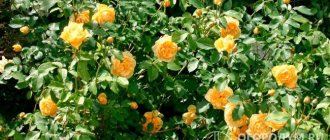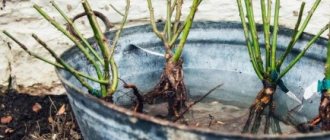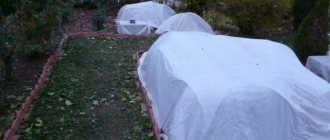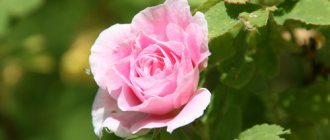Roses from the French enterprise Delbar appeared in Russia relatively recently. And they immediately captivated flower growers with their charm. Delbar's varietal collection is divided into several memorable series. One of them - Great Flowers, includes a hybrid tea variety with a unique flower color, whose name is Empress Farah.
Characteristics of the flower
The shape of the bush in this species is vertical, gradually expanding from the root to the top.
The plant is quite tall, sometimes reaching 2 m in height, but more often it does not exceed 1.5-1.6 m. The width of the bush is from 0.8 to 1.2 meters. The shoots are powerful, dotted with a moderate number of thorns. The thorns have a very wide base, grow upright, and have a slight slope towards the bottom.
The rose bush is very dense, abundantly covered with leaves. The leaves are quite large and glossy. The leaf blade is straight-shaped, very soft to the touch, light green in color. Each shoot produces 1 bud. The bud of the flower is goblet-shaped.
The petals are white, with crimson edges. They are planted very tightly to each other, so when the buds open, they begin to turn outward, which is why only the colored crimson edges are more visible.
When turned out, the leaves take on a pointed appearance.
The Empress Farah flower is quite large, up to 12-13 cm in diameter. It consists of a relatively small number of petals (from 17 to 25).
The first flowering of the Empress occurs already in the second year after planting in open ground. The aroma of the flower is not pronounced; it is almost impossible to sense it from a great distance. In the morning the scent of the rose is more intense, and by evening it practically disappears.
The smell is more fruity than floral.
Empress Farah is a heat-loving plant. However, it can also survive winter frosts that drop below -23 degrees Celsius. In regions where the temperature drops below -23 degrees Celsius, the bush will need good shelter for the winter.
The Empress's immune system is at a high level. Unlike many other hybrid roses, it is resistant to powdery mildew and black spot. At the same time, the flower is not protected from such a scourge as rust.
As for insects, aphids can create serious problems.
The flower is also resistant to high humidity. Flowers do not deteriorate, do not get wet or rot.
Description of the variety
Imperatrice Farah
The unusualness of the flower is that it has a non-standard transition from white to crimson-red color. The flower bud is a classic glass with twisted petals.
The flower looks very elegant due to the fact that the tips of the petals are bent outward only where they are colored with carmine. Carmine strokes are visible even when the flower bud has not yet opened.
The plant has virtually no contrast between the flower and the leaves; the leaves are light green.
The Empress Farah rose variety, despite its exclusivity, is completely unpretentious in care and is not susceptible to various diseases. Throughout the entire life of the bud, it does not lose its decorative effect at all, both at the stage of bud formation and when the flower fully blooms.
The year of introduction is considered to be 1992. This year, the Empress Farah rose received many awards in Geneva, Tokyo and other cities.
On the territory of Russia, the rose variety Empress Farah also became known in 1992, although no one knew exactly the true name, but it was believed that this series included 6 cultivars, with very large buds, and they were created by the house of Delbar. Today, the Empress Farah variety is available in every corner of Russia, but some gardeners still select five more varieties for it “for their retinue.”
This variety of rose is used for landscaping and is also suitable for cutting. Flowers bloom for a very long time, and repeatedly throughout the summer season. If you plant Empress Farah in the sunny part of the site, then receiving a large amount of sunny color, the buds will be more saturated with pronounced two-color tints.
Rose buds are quite large and can reach 13 centimeters, bloom smoothly, and look like double flowers. Flowering occurs for a very long time, slightly wave-like, which is almost imperceptible.
The aroma of rose is very subtle, one might even say slightly noticeable. However, this property is offset by the deep contrast of the bud colors.
Rose bushes are of the erect type, vigorous. They can reach a height of 120 centimeters. The leaves are quite large and shiny, practically not susceptible to disease.
Bright flowers with a touch of nobility delight almost all gardeners, and therefore the Empress Farah rose is on the lips of all gardeners!
History of variety development
This hybrid tea variety was bred by breeders from France at the end of the last century. These specialists are responsible for a large number of new hybrid tea varieties bred over several decades.
Among them is the Empress Farah rose variety - it is one of the most beautiful and original, with a delicate aroma. And this “queen of flowers” received the name in honor of the only woman in Iran who was crowned on the throne - the wife of the Shah of this state, the smart and lovely Farah Pahlavi.
This empress led an active social life, was also involved in government affairs, but still found time to tend to her garden. And roses were the special love of this empress.
Therefore, breeder Henri Delbar, who was the author of the variety, noted that this variety in its qualities corresponds to the greatness of this empress, and therefore was honored to bear her name.
Description of the hybrid tea rose variety Princess of Monaco
The bushes of this variety are erect and vigorous. The shoots of the Princess of Monaco rose can grow up to 1.0 m in height, and the width of an adult bush can be up to 0.6 m. The opening buds have a weak but very pleasant aroma. The shoots are well leafed, the foliage is typical of rose bushes, medium in size, with sharp tips, dark emerald color, with a characteristic shine of the upper leaf blades.
Beautiful roses! Roses FLORIBUNDA STROMBOLI Roses Abracadabra Each shoot produces one flower with a diameter of up to 14 cm, so the Princess of Monaco rose is classified as a large-flowered rose
. Flowering of this variety begins in June and continues throughout the season.
Blooming densely double buds do not open completely. The petals have a two-color color - the middle is white with a cream tint, and the edges are soft pink, which darkens and becomes dark crimson as the flowers bloom.
Video about roses Princess of Monaco
Princesse de Monaco rose buds bloom slowly - within 10-12 days
. Cut flowers can stand in water for up to 2 weeks, which makes this variety attractive to florists - they use the Princess of Monaco rose to make bouquets and holiday arrangements.
Important!
During the flowering period, this shrub requires heat and a lot of sunlight - during the rainy season the buds stop opening.
The faint aroma of opening flowers reveals fruity notes.
Photo of rose Princess of Monaco
The rose variety Princess of Monaco is frost-resistant - the bushes can withstand temperatures down to -29 degrees Celsius
. However, experts recommend covering the Princess of Monaco rose for the winter in regions with winter temperatures below -20 degrees.
The variety has high immunity, so it practically does not get sick and is not attacked by insect pests.
Growing roses at home
The rose is unpretentious, frost-resistant and easy to care for.
Preparing for landing
This variety should be planted in a well-lit place, protected from drafts and cold winds. When planting “Empress Farah” in the shade, the splendor and brightness of its flowering is lost. Loamy, slightly acidic soils are well suited for planting. Roses also do well in other types of soil, as long as they are not too heavy or overly moist.
VIDEO: FEATURES OF PLANTING ROSE SEEDLINGS IN SPRING Before planting, the selected area must be dug up. For digging, per one square meter of soil it is necessary to add:
- 10-20 kg of compost or humus;
- 200 g wood ash;
- 400 g lime and 2 tbsp. l. superphosphate.
It is advisable to prepare a planting hole 50-60 cm deep 3-4 weeks before planting. A mixture of the top soil layer and compost or humus in equal quantities is poured onto its bottom.
Important! The indisputable advantages of the Empress Farah variety are the dense arrangement of petals, long flowering and suitability for cutting. Find out what mistakes gardeners make when growing roses
Find out what mistakes gardeners make when growing roses.
Care and feeding
The main care of the plant consists of regular watering and fertilizing. Roses need to be watered when the top layer of soil dries out, and each adult bush requires at least a couple of buckets of water.
From the second year of growth, the bushes need to be fed every 2-3 weeks throughout the season. To do this, you can alternately use organic and mineral fertilizers.
- The first fertilizing is done after the spring opening and hilling, in which case you can mix the soil with rotted manure (0.5 buckets) and pour it into the plant’s trunk circle.
- At the stage of development of rose buds, they need phosphorus-potassium fertilizers (100 grams of superphosphate and 30 grams of potassium sulfate per bucket of water).
Transplantation and propagation
To transplant to another place, the bush is carefully dug up and removed from the soil, and its roots are washed with clean water. Then you should divide the plant into separate bushes and plant them in pre-prepared soil
Bloom
Rose Nostalgie - what is this standard variety?
The buds on a rose of this variety bloom in two waves from the beginning of summer to the second ten days of October. Flowering is characterized by lushness and rich color tints.
Period of activity and rest
Roses are at rest with slow sap flow from the end of October until the end of the first ten days of spring. Activity is observed in the summer months, starting from the end of May - then Empress Farah blooms especially magnificently.
Care during and after flowering
During bud setting and flowering, watering and phosphorus are required. Lack of moisture during this period can cause premature leaf fall and poor flowering.
After the flowers dry (late summer), they stop applying fertilizers so as not to provoke the growth of new shoots and feed the plant with potassium mixtures for better wintering.
What to do if it doesn't bloom
A rose can give a bad color if there is a lack of soil moisture or if there is a deficiency of minerals in it. The problem can be solved by regular complex feeding of potassium and phosphorus, as well as increased watering.
Diseases, pests and ways to combat them
Roses of this variety have innate immunity to major flower diseases. But it happens that it is systematically affected by rust. You can get rid of it by removing damaged areas.
Periodically, the bushes need to be sprayed with soapy water or other insecticides. Among insects, aphids love to feast on this rose. You can wash it off with powerful water pressure, remove damaged leaves, or purchase a special product against this popular pest in the store.
Rose Empress Farah can be an amazing addition to a gardener's collection. Even a beginner can cope with its breeding. They also love it because it retains its freshness for a long time and does not fade in bouquets. Roses with long stems are very popular now; they are quite expensive in stores. But you can grow this beauty in your flowerbed and enjoy its marvelous appearance throughout the season.
Planting in open ground
For the successful establishment of flower queens on the site, it is necessary to provide for all the important points: planting time, choosing a place for a flower bed, preparing the soil.
Roses are grown from seeds, stem cuttings, plots from a whole bush, and root cuttings.
The easiest and most reliable way to grow young bushes is from cuttings.
Rose cuttings
What time to plant
Flower growers recommend carrying out this operation in the second ten days of April, if by that time the street air is warm enough. If the frosts ended even earlier and do not return, you can start planting.
Selecting a location
Hybrid tea varieties are very light-loving, so the future flower garden should be well lit by the sun and also sufficiently ventilated.
Important! You should avoid blowing the area with cold winds, as well as shading, otherwise you won’t have to wait for a lush color
How to prepare the soil and flower for planting
Roses are not very picky about soils - any soil is suitable for them, except one that is too heavy or light. Loams that are slightly dry and have an acidic Ph level are best suited for these beauties.
To prepare for planting, you need to dig up the soil and add a mixture of fertilizers:
- humus (compost) in a proportion of 10-20 kg per 1 square meter;
- 200 gr. ash;
- 400 gr. lime;
- 2 tablespoons of superphosphate mixture.
It is advisable to complete the preparatory procedures at least a month before planting the seedlings, preferably even in the fall.
The planting hole is dug to a depth of 0.5−0.6 m, at the bottom of which a mound of soil and humus with compost is formed.
Boarding procedure
Before planting, cut off damaged areas on the roots of seedlings, trim them slightly and treat them with a growth stimulator. You should also leave only a couple of buds on the shoots.
The seedling is placed in a prepared planting hole, the roots are carefully distributed over its entire surface and covered with soil, which is slightly compacted from the outside. Afterwards, you should water the future bush and mulch it with peat.
Choosing a location and conditions of detention
To plant roses, you need to find a well-lit area with sun. If there is not enough sunlight, the color of the petals will become more faded and the splendor of flowering will be lost.
The planting site should not be blown by cold winds; this rose does not like drafts, but it is better to avoid stagnant air.
It is advisable that groundwater does not come close to the root system of the plant, otherwise the roots may rot.
The ideal soil for roses is loamy, moderately dry, with a slightly acidic reaction. However, roses are not picky about soils, as long as they are not too heavy or too light.
Features of caring for the Empress Farah rose
The rose of this variety is completely unpretentious in care, but for abundant and beautiful flowering and a long life of the bush, certain agrotechnical rules must be followed.
Watering
In arid climates, the rose must be watered as the earthen ball dries out; in hot summers, watering should be more frequent; about 2 buckets of water at room temperature are needed per plant. It is undesirable to overdo it in watering, so as not to provoke rotting of the roots.
Top dressing
From the second year of life, the rose must be fed once every two to three weeks, alternating mineral and organic fertilizers. Feeding should begin immediately after removing the winter shelter. At the stage of bud emergence, fertilizing with potassium fertilizers is required. Mineral fertilizers must be applied after watering.
Trimming
The main pruning is done in the spring. Shoots damaged over the winter are pruned to a healthy place. Strong shoots are shortened to 2-4 buds. In autumn, when the first frosts begin, it is necessary to cut off the last flowers and remove weak and broken shoots, cut the rest by half.
Before sheltering for the winter, you need to remove all leaves from the remaining shoots. But this must be done when the temperature drops to -10 degrees, otherwise the rose may sprout sprouts and buds again, which is very undesirable, because the plant will be greatly weakened before winter.
Hilling and loosening
Rose bushes need to be earthed up twice a year - in mid-October and after frost sets in. To do this, the soil is mixed with fermented manure and the bushes are hilled with the mixture. Loosening of the root area should be done after each watering for better soil permeability. It is also necessary to promptly remove weeds that take away moisture and nutrients from the bush.
Transplantation and propagation
Roses are propagated by dividing the bush and cuttings. When replanting and dividing the bush, the plant is removed from the soil, the roots are washed well with plain water and divided into several parts. The resulting seedlings are planted in a new place. Typically, these activities are carried out in the spring, after the onset of persistent heat.
Cuttings are harvested and rooted in the summer. For this purpose, choose long shoots with unopened buds. Cuttings are cut from the center of a stem 8 cm long with 2-3 buds. The upper cut is made straight, and the lower one at an angle. In order for the cutting to take root faster, it is placed in a jar of boiled water with the addition of a growth stimulant. As soon as the roots appear, the cuttings must be planted in the soil, covered with a jar on top, and conditions of high humidity must be created by spraying them with water daily.
Disease and pest control
The Empress Farah rose variety is highly resistant to common diseases such as powdery mildew, black spot and gray rot. But sometimes it gets attacked by rust. You can fight this scourge only by removing the affected leaves in a timely manner. During the summer, spray the bushes with 2% Bordeaux mixture or a copper-soap solution, a decoction of nettle or wormwood. The underside of the leaves must be treated especially carefully.
Of the pests, roses are especially loved by aphids. You can fight it by spraying with insecticides Actellik, Aktara, Fufanon. Or folk remedies - a soap solution with the addition of a decoction of tobacco, ash and kerosene.
Preparing for winter
With the onset of frost -10 degrees, the rose must be covered. Before doing this, prune, remove leaves and mulch the root soil. Cover the remains of the bush with spruce branches.
Flower propagation
The rose is propagated by cuttings. For this purpose, half-lignified cuttings are selected.
Cuttings are cut during the period when buds appear. They are cut early in the morning.
The process of rooting cuttings
Detailed description
The central part of the shoot, on which there are 2-3 leaves, is cut off. The length of the cut stem should be about 7 cm. The upper cut should be made at an angle of 90°, the lower - 45°. There must be at least two buds on the cutting. Cuttings are treated with root growth stimulants. They are immersed in it for a day (maybe a little less), about 2-3 cm. Then they are rinsed with water and rooted. This is done in two ways:
- Future plants are placed in a glass of boiled water at room temperature and placed in a shaded place. The water is changed once every two days.
- The cuttings are planted in a box with soil consisting of turf with compost, sprinkled with a layer of river sand on top. The shoots are watered, covered with film, and placed in partial shade. Every 2-3 days they are ventilated and moistened. After 2-3 weeks, mineral fertilizers begin to be added to the soil.
When roots appear on the seedlings, they can be planted in open ground.
Important! If you plan to reproduce the Empress, then in the spring no mineral fertilizers are applied to the bush.
Growing
Planting is done using seedlings.
You can plant a rose when:
- The threat of frost has long passed;
- The nights become warm;
- The soil warms up well;
- Daylight hours have lengthened significantly.
If all conditions are met, you can plant the rose in open ground.
Planting in open ground
The rose is planted in holes filled with compost or humus. Additionally, fresh manure is added. A week after planting, mulching with peat is carried out.
Boarding time
In the Russian central zone, planting is carried out in the second - third ten days of May. In more northern regions, this time shifts by about a week (30th of May). The weather during planting of seedlings should be sunny and dry.
Selecting a location
The place should be bright, well protected from the wind (for example, next to fruit trees, but not in the shade). It is desirable that groundwater lies as far from the surface as possible.
The plant loves the sun and tolerates partial shade well.
Preparing the soil and flower
The Empress rose should be planted in holes filled with a nutrient mixture. Ash and complex superphosphate fertilizer are added to the compost (humus). The day before, the planting material is cut and soaked in a growth stimulator.
Step-by-step instruction
The seedling is carefully placed in a dug hole and covered with earth. The soil is not compacted
After this, watering is carried out. You can spud it up a little. In the future, it is necessary to water as the soil dries out.
Care
The main care activities are:
- Trimming;
- Watering and loosening;
- Feeding;
- Preparing for winter.
Proper care is necessary for the plant to maintain its spectacular appearance for a long time.
Watering rules and humidity
One bush needs 2 buckets of water. If the summer turns out to be rainy, this dose decreases. You can’t water it often so as not to destroy the roots. The recommended time for watering is morning and evening, when there is no extreme heat.
Do not allow the soil to become waterlogged
Fertilizing and soil quality
Rose Queen Farah loves slightly acidic soils and does not grow well in sand and marshy areas. The soil should be loose, with a large percentage of loam. When feeding, special complex fertilizers for roses are used.
Attention! Nitrogen fertilizers must be applied strictly according to the instructions. The plant does not like an excess of this trace element
Pruning and replanting
The main purpose of pruning is the correct formation of the crown and the removal of diseased, deformed shoots. Pruning is carried out immediately before wintering. It is better to replant as rarely as possible - the plant has a very sensitive root system.
Features of wintering
The flower tolerates frost well. Before leaving for the winter, the plant is fed one last time by loosening the soil. Spruce spruce branches are used as a covering material.
During periods of activity and rest
The dormant period of the Emperor Farah rose lasts quite a long time: from October to the end of March. The peak of plant activity occurs at the end of May - beginning of June, it is at this time that most varieties of Empress Farah bloom.
During and after flowering
During flowering, potassium fertilizers should be regularly applied; they contribute to the proper formation of buds. In autumn, fertilizing should be reduced. When the rose has completely faded, pruning is carried out to remove dried flowers and deformed branches.
What to do if it doesn't bloom
If Empress Farah does not bloom, the situation can be saved by timely application of complex fertilizing. Rose responds well to potassium and phosphorus. You can also try increasing watering, especially in hot weather.
Growing a flower
Flowers are planted using seedlings.
Rosa Minerva - growing floribunda
Hybrid tea rose Farah is planted in open ground in early May.
The planting site should be sunny, protected from drafts, with a low level of groundwater.
To prepare seedlings for planting, they need to be cut, treated with a growth stimulator, and placed in a mixture of clay and water for 2 hours. Rose requires slightly acidic, loose, loamy and nutritious soil.
Interesting! If the soil is not acidic enough, kefir is added to it. At high acidity levels, lime and ash are added to the soil.
Step by step landing procedure:
- Prepare a hole, the height and width of which will be about 50 cm.
- Place a drainage layer and mineral fertilizers on its bottom.
- Place the seedling in the center of the hole, carefully straighten the roots, cover with soil so that there are no empty spaces left.
- Water generously and place a layer of loose soil on top.
- After a few days, when the plant has taken root, remove the top layer of soil.
It's worth adding a layer of mulch. Hay or straw work well for this.
Phenomenon: a person who does not age
Every year there are more cases when a person not only stops aging, but also begins to look younger. They do nothing to rejuvenate, neither in terms of lifestyle changes, nor in terms of medical intervention. Scientists call this phenomenon a phenomenon. Its nature is not clear, but is of great interest.
Cases of stopping aging and turning aging into rejuvenation are different. These stories have both a happy ending and a sad one. There are children who remain at their age immediately after birth. Their bodies age, but unevenly, causing deformation. The aging process is slow. One year of growing up for such children is equal to 4 years for ordinary children. Such a child will never be able to grow old, because he will die from other causes prematurely. For parents, this is not a miracle, but a real disaster. Scientists believe that the cause lies in gene mutation. But they can’t say anything for sure yet.
There are also people who stop aging after certain circumstances occur. They quickly get younger, but then they begin to age again more intensively than before and die. Also, there are more optimistic cases when a person simply does not age as quickly as ordinary people. The rate of his aging is so slow that it is almost invisible to others.
Ageless Candy Lo
The model is of Chinese origin. Candy is now 50 years old, but she looks like a 30-year-old woman in her prime. Mother of three children. She believes that slow aging in her case is associated with an ideal lifestyle, the absence of bad habits, a positive psychological attitude and sports. Realizing that she was significantly younger than her peers, Candy used her advantage for commercial purposes by writing a book about her story. The book is called Timeless.
Young Rosa Faroni
This woman is now 97 years old, can you believe it? This is exactly the man who, having lived to 97 years, still does not age. On the contrary, Rosa Faroni became so much younger that her acquaintances no longer recognized her, confusing her with her daughter.
Now she jokes about how if she decides to get pregnant, wouldn't it be funny to give birth when her 100th birthday is around the corner? At the same time, as gerontologists note, she became younger not only in body, but also in mind.
All her data is at least 70 years younger than her passport age. She has a sharp mind, excellent memory, and physical fitness. All her life she never followed any diets, did not lead a healthy lifestyle, smoked and drank. This is a real phenomenon.
Sleepless Yakov Tsiperovich
At 58 years old, this guy looks like he's in his 30s. This is a man who lives in Germany. After a clinical death experience that lasted about an hour, he woke up and stopped aging. This happened in 1979.
An interesting fact about this man’s story is that he doesn’t need sleep. He can't sleep at all. He learned over time to give his body a horizontal position, but it does not need sleep.
In order to learn to lie down on the surface without hindrance, he needed time and yoga classes. Now Yakov Tsiperovich is 58 years old, he is completely healthy and looks exactly the same as he did before his clinical death.
Ageless Sei Senagon
The Japanese woman Sei had just turned 75 years old when she stopped aging. She began to look younger. The physiological process of her body has completely turned into a process of rejuvenation. Hair and teeth were renewed, wrinkles disappeared, the menstrual cycle started again, and sexual desire appeared. Over time, the woman began to look completely young. She had to divorce her husband and remarry a younger man, with whom she had a child.
About the secrets of landing
Rose Empress Farah Imperatrice Farah can decorate a garden plot in any part of the country. In order for the seedlings to feel good, it is recommended to choose a sunny place, protected from northern winds
It is important that the bush is not located in the shade, since a lack of light will lead to a loss of flower splendor. The soil should not be heavy
Loamy, slightly acidic soil is suitable.
Before planting the hybrid tea rose Empress Farah, you need to dig the soil deeply. During digging, useful mineral supplements are added to the ground. Feedback from flower growers recommend preparing the soil for planting hybrid tea rose seedlings in the fall. As a last resort, this can be done a month before planting the sprouts. Thanks to the advance preparation of the soil, all the useful components will have time to open up and enrich the soil.
Description of the Empress Farah rose in the encyclopedia of flowers recommend planting the plant trunk deep. The planting hole must be at least 60 cm deep. A small amount of soil with compost and humus in equal parts is poured into the bottom of the hole. The roots are shortened a little, and the shoots are cut to 2-3 buds. Before burying the seedling with soil, the root system should be treated with a special stimulating drug.
Advantages and disadvantages
Among the advantages, everyone notes the unusual sweet and sour fruity aroma of Imperatrice Farah; the rose has an attractive appearance due to its two-color and large size of glass-shaped noble flowers, which remain decorative and do not fall apart when fully bloomed. Withstands both sun and wind. The blooming flower lasts a very long time and is beautiful to cut.
Among the shortcomings noted:
- the thorniness of the bush, which makes it difficult to care for;
- without fertilizing and pruning it blooms poorly;
- weak aroma.
With proper care, Rose Empress Farah will delight the eye with unusually bright flowers. It is suitable both for decorating the site and for cutting.
The French know a lot about the selection of exquisite roses. We all know the Red Intuition rose, which came to us from France. And no less popular Frenchwoman is Empress Farah.
This variety appeared in the Russian Federation relatively recently, although in fact it is a fairly old variety with an interesting history. The development of Empress Farah was carried out by the French company Delbar.
Empress Farah is a hybrid tea rose.
And today we will present a detailed description of this flower, its photo and reviews of those people who encountered the Empress live.
History of creation
The name of this beautiful rose has an interesting backstory. In 1967, for the first time in the 2,500 years of the Persian monarchy, a woman was crowned - the third wife of the Iranian Shah Reza Pahlavi. Her name is Farah Pahlavi, and she is one of the most beautiful and charismatic women in the world. It was thanks to her that Iranian women stopped hiding their faces and hands. She was at the forefront of creating orchards in northern Iran. Thanks to this project that never took place (the revolution interfered), in 1974 Farah met the French rose grower Delbar. A few years later, the shahina, who was in exile, was unexpectedly met by the son of Georges Delbart, Henri, who invited her to visit the nurseries and rose gardens belonging to their family. It was there that Farah Pahlavi was asked to name one of the roses that had unusual qualities after her.
The variety has been grown in nurseries for several years. In 1986, it was known as Strawberry Parfait. But it was introduced to a wide range of professionals and amateurs only in 1992 under a new name - Imperatrice Farah. Registration name: DELivour. In the flower market, Empress Farah is also known under other names - Empress Farax, Kaiserin Farax.
Characteristics of the flower
The shape of the bush in this species is vertical, gradually expanding from the root to the top. The plant is quite tall, sometimes reaching 2 m in height, but more often it does not exceed 1.5-1.6 m. The width of the bush is from 0.8 to 1.2 meters.
The shoots are powerful, dotted with a moderate number of thorns. The thorns have a very wide base, grow upright, and have a slight slope towards the bottom.
The rose bush is very dense, abundantly covered with leaves. The leaves are quite large and glossy. The leaf blade is straight-shaped, very soft to the touch, light green in color. Each shoot produces 1 bud. The bud of the flower is goblet-shaped.
The petals are white, with crimson edges. They are planted very tightly to each other, so when the buds open, they begin to turn outward, which is why only the colored crimson edges are more visible.
When turned out, the leaves take on a pointed appearance.
The Empress Farah flower is quite large, up to 12-13 cm in diameter. It consists of a relatively small number of petals (from 17 to 25).
The first flowering of the Empress occurs already in the second year after planting in open ground. The aroma of the flower is not pronounced; it is almost impossible to sense it from a great distance. In the morning the scent of the rose is more intense, and by evening it practically disappears.
The smell is more fruity than floral.
Empress Farah is a heat-loving plant. However, it can also survive winter frosts that drop below -23 degrees Celsius. In regions where the temperature drops below -23 degrees Celsius, the bush will need good shelter for the winter.
The Empress's immune system is at a high level. Unlike many other hybrid roses, it is resistant to powdery mildew and black spot. At the same time, the flower is not protected from such a scourge as rust.
As for insects, aphids can create serious problems.
The flower is also resistant to high humidity. Flowers do not deteriorate, do not get wet or rot.
Planting and agricultural technology
As befits a royal person, Empress Farah is a rather capricious plant. Prefers autumn planting. The place in the flowerbed should be well lit, protected from strong winds, but at the same time slightly ventilated. Loose and nutritious loams are suitable soils. In heavy and cold clay soils, the rose becomes sick and does not show its decorative value. If the area is often flooded, then a thick layer of drainage - broken brick or large expanded clay - should be laid at the bottom of the planting hole. Watering should not be frequent, but plentiful. Treatment against diseases and pests is required. It is not recommended to leave faded flowers on the bush, as this inhibits the development of new buds. Thinning pruning is necessary; it reduces the risk of developing fungal diseases. In spring, old, broken and frozen branches are removed. In warm climates, pruning can be done shorter, in cooler climates - by about 1/3. If the winter is snowless and very cold, be sure to insulate the plant - mulch the tree trunk circle with dry soil, cover the bush with spruce branches or any non-woven material.
Empress Farah is a real decoration for any flower garden. But you need to choose neighbors for a royal person very carefully, so that they serve as a background against which the unusual color of the variety will sparkle like a well-cut diamond. One of the disadvantages is the thorny shoots. Before purchasing a variety, you should make sure whether the climate of your region is suitable for roses and whether you can provide the beauty with decent care.
An unexpected sequel
The story had a fabulous continuation. Henri Delbard (the son of a breeder), accidentally found himself in the shop of a Parisian florist, and met Shaheen Farah there. The woman attracted his attention with her unusual voice. Henri introduced himself to the woman. Having learned who she was, he invited her to visit his father in Millicorne.
The Empress did not refuse the visit, during which it was proposed to name one of the varieties of roses, which had rare virtues, after her.
At that time, there were rumors among amateur gardeners that the Delbard company had released a series called “Roses of the Shah,” although no one knew the true name. The flowers that were included in it were distinguished by their large size and unique aroma. No one knew the names of the varieties, but the series was associated with the name Imperatrice Farah. There have been many attempts by gardeners to compile this series from available varieties.
Currently, this Empress Farah variety is not uncommon, but many gardeners are still trying to find five more varieties to complement it.
In 1992, the species became the owner of numerous awards and prizes received at major competitions. In 1995, the Empress Farah rose received the title “Crystal Rose” at the competition in Orleans.
Features of cultivation
To begin with, we note that caring for this variety is not particularly difficult; you just need to follow the basic rules, which we will now briefly outline.
The first thing to consider when choosing this beauty as an ornament for your garden is the planting location. As already mentioned, if you plant a flower in a shaded place, it will quickly grow tall, but in the sun the bush will grow a little slower.
Another important point is watering the rose, because it is important not to overwater the plant (this can lead to the appearance of various diseases and cause rotting of the roots). Usually the flower is watered when the top layer of soil is completely dry.
If the summer turns out to be rainy, the amount of watering should be reduced. As a rule, about 2 buckets of water are consumed per bush.
Fertilizing should also be given special attention, because the plant must receive all the necessary elements. Fertilize them once every 2-3 weeks, and it is recommended to alternate mineral and organic fertilizers to maintain balance
All fertilizing should be applied immediately after the plant is watered. It is also worth noting that Empress Farah needs hilling, which is carried out in early spring.
In addition, it is necessary to regularly prune the plant so that it grows properly and pleases you with its flowers. As a rule, pruning is carried out in the spring: it is necessary to remove all damaged shoots, and leave 2-3 buds on the strongest ones. Before autumn frosts, the rose is prepared for wintering. To do this, cut off all the flowers and leaves.
It is important to calculate the time correctly and not do this too early, otherwise new leaves will grow, and for a successful winter they should not remain on the rose. All weak shoots are also removed, and the remaining ones are cut off by about half
In order for a flower to successfully overwinter, it is enough to simply hill it up (as a rule, this procedure is carried out in two stages). The hilling height should be about 30–40 cm. Such shelter will be enough for your beauty to successfully survive the winter frosts.











